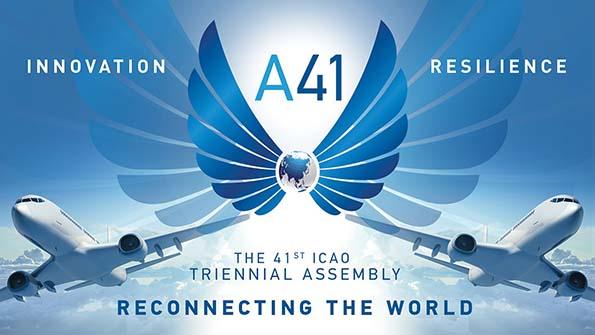
Just ahead of the ICAO 41st General Assembly, IATA director general Willie Walsh gave the chances of the United Nations’ aviation body agreeing to a 2050 net zero carbon emissions goal as a “four out of five.”
In terms of importance, he added, the issue was a “five out of five.”
Negotiations on the 2050 long-term aspirational goal (LTAG) continued to the very end of the two-week assembly in Montreal—not surprising given where different nations sit in terms of economic and aviation growth and where they are in access to sustainability technologies and sustainable aviation fuel (SAF).
But on Oct. 7, the LTAG was adopted, falling in synch with a global airline 2050 net zero resolution adopted at the IATA AGM in Boston almost exactly a year earlier.
Not all 193 ICAO member states were onboard. The delegates for China, Eritrea, Russia and Venezuela formally expressed their reservations about the LTAG. China and Russia also had reservations about changes in the CORSIA global aviation carbon offsetting scheme that were adopted at the same assembly.
China’s LTAG concerns are mostly about the timing. Directly before the IATA 2050 resolution was adopted, Chinese major airlines expressed support for the intention, but wanted a 2060 deadline. That was unacceptable to many other airlines, especially those in Europe that are under pressure to get to net zero by 2040. Beijing, preoccupied with a different zero goal—achieving zero COVID cases—has essentially locked its borders and reversed its policy of international aviation growth.
Air Transport Action Group executive director Haldane Dodd said the net zero goal was “shaped in a way that allows for different speeds of decarbonization by countries around the world, ensuring that each government can respond to its own national circumstances but within a common global framework for aviation.”
Dodd believes that China “has a keen interest in pursuing greener aviation and will undertake many of the same activities to decarbonize as other ICAO States, and in a similar timeframe, but on their own terms. In the end, the same results will be achieved.”
Russia, a global pariah since it invaded Ukraine, has also forced a halt on its international aviation growth. The country was unceremoniously kicked off the ICAO board during the assembly after falling short of the 86 votes it needed to be reelected. It was no surprise that Russia thereafter failed to support the LTAG. With Russian President Vladimir Putin threatening nuclear warfare, no one is interested in Russia’s take on sustainability.
SAF Motivator
For Dodd, the most important result from the establishment of the LTAG is how it will help unlock investments needed in SAF and set a baseline policy at a global level.
“That will need to be translated into national actions and policy, but having this framework is vital for the stability or trajectory across the world,” he said.
IATA has estimated that SAF will represent roughly 65% of the mitigation needed to achieve net zero emissions by 2050.
But the harmonization of SAF policy will be a challenge. During an Aviation Week webinar ahead of the ICAO assembly, Dodd explained that a useful area for the organization was creating a toolbox of options for ICAO member states to jumpstart capacity building for SAF.
“There are a whole range of policy options that can be tailored to local contexts,” he said.
Just as ICAO must navigate the different timelines some countries are establishing to meet net zero emissions, it will also have to take into account the different approaches countries adopt in developing SAF, starting with the US and the European Union (EU).
The 2022 US Inflation Reduction Act introduced a tax credit to make the price of SAF more competitive. In an address at the ICAO Assembly, transportation secretary Pete Buttigieg highlighted that the national goal was to produce “enough SAF to power all US aviation” by 2050.
In Europe, discussions are continuing regarding the RefuelEU legislation that includes SAF blending mandates. Unsurprisingly, the EU’s approach, which adopts a laws and mandates stick versus the US’ motivational carrot, is getting pushback.
“Some industry bodies are actually blocking or lobbying against some of these ambitious measures,” Jo Dardenne, the director of aviation at the non-governmental organization Transport & Environment, said during the webinar. “We in Europe have chosen the mandate approach because we actually believe that regulation is the way forward.”
There will not be a one-size-fits-all approach to building up SAF capacity and production. But sticks and mandates are only useful where there are solutions and SAF supply remains extremely limited almost everywhere. As Walsh has pointed out, where SAF is available, airlines are buying every single drop.
In these circumstances, a blunt mandate “almost presents a bit of a tax on the industry that only ensures the energy companies that produce that fuel get good profits out of it rather than actually giving the supply a push that’s needed,” Dodd explained.
The LTAG goal—albeit it a compromise and relatively weakly worded—was at least a start to getting worldwide government policies in place that support and incentivize the development and production of mass-scale SAF. In that respect, it met IATA’s hopes.
But to be effective, this can only be the beginning. IATA is already pushing for a more robust declaration of climate change goals from the organization. “By the next assembly the ‘aspirational’ characterization of LTAG must be transformed into a firm goal with a clear plan of action,” Walsh said.
ICAO holds its General Assembly every three years. In the race to address climate change and aviation sustainability—a five out of five issue—that’s far too long to wait-and-see.




